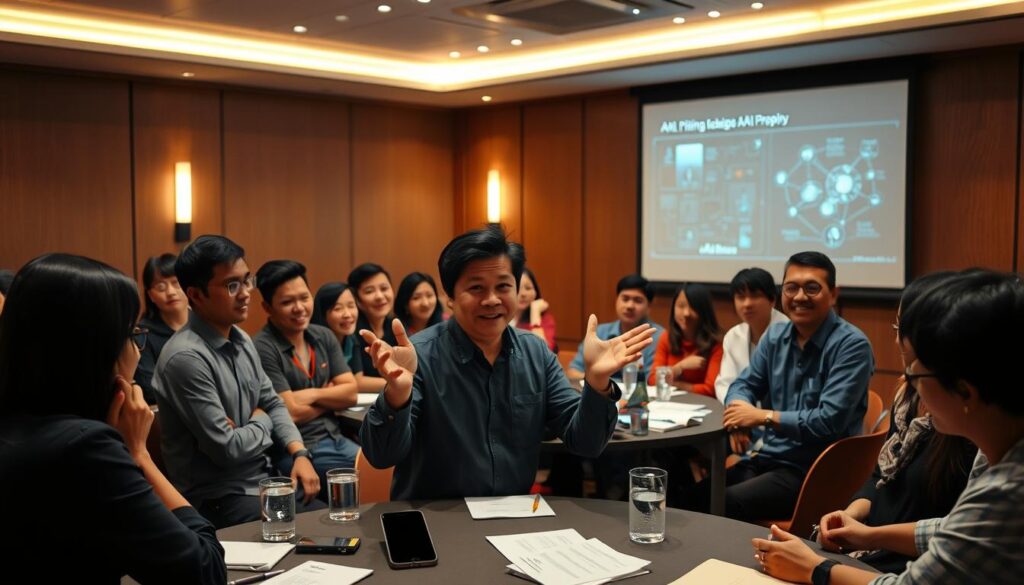Ever wondered why some AI projects succeed while others fail? The key is in the art of making a great AI pitch. It’s not just about the facts; it’s about winning over stakeholders with your words. This guide will show you how to pitch AI projects like a pro, grabbing everyone’s attention and sparking interest in new ideas.
By learning from the best and focusing on clear, persuasive speaking, you can make your AI project a top priority in your company.
Key Takeaways
- Understanding the significance of effective pitching for AI initiatives.
- Engaging stakeholders through clear and persuasive communication.
- The role of storytelling in crafting compelling AI pitches.
- Identifying your audience to maximize impact.
- Building trust and credibility for successful buy-in.
Understanding the Importance of an Effective AI Pitch
Making a good AI pitch is key to getting everyone on board and setting up for success. It’s not just about numbers or data. It’s about telling a story that shows how AI can change things for the better.
Good communication is crucial. It helps stakeholders see the real value of AI. A strong pitch shows the benefits and answers any doubts. This builds trust by linking AI to things the company cares about.
The real value of an AI pitch is in convincing and uniting stakeholders. A good story can turn doubts into support. This makes it easier to get the resources and support needed for new projects. Knowing what matters to stakeholders makes the pitch more than just information. It inspires action.
Identifying Your Audience for Maximum Impact
Knowing who your audience is is key to a successful AI pitch. Your audience might be tech experts, business leaders, or people who don’t know much about tech. It’s important to tailor your pitch to their interests. This way, you can speak directly to their needs.
To get their attention, focus on what they care about most. For instance, tech teams might love data and how things perform. But business leaders might be more interested in how it helps the company grow. By understanding these priorities, you can make sure your pitch hits the mark.
Don’t forget about cultural differences, like in Southeast Asia. These differences can really affect how people make decisions. By adjusting how you talk to fit these cultural differences, you’ll connect better with your audience.

Harnessing AI to Enhance Your Pitch Strategy
AI can make your pitch strategy better and more engaging. It helps you find weak spots in your presentation. This way, you can fix them and make your pitch stronger.
Tools like Merge give you feedback on how to make your pitches more compelling. This feedback helps you improve your message. It also makes sure your content matches what worked well in successful pitches.
Using AI in your process makes your presentations clearer and more insightful. It lets you present stronger arguments. This makes it easier for people to get excited about your vision.
Adopting AI shows you’re committed to new and better ways to present. It helps you create pitches that grab people’s attention. As your pitches get better, so do your chances of success.
Storytelling Techniques for Compelling AI Pitches
Storytelling in pitches can turn a simple presentation into a memorable experience. Strong narratives grab the audience’s attention and make complex ideas easier to understand. Companies like Pixar show how storytelling can make pitches more effective. They use a structured approach to connect emotionally with their audience.
A clear story can show how AI solutions can make a difference. It’s key to share a compelling vision with stakeholders. This helps them see the future you’re proposing. It makes your message hit home, boosting your presentation’s impact.
Using engaging stories can make technical terms easier to grasp. A well-told story encourages stakeholders to see the value in AI. When people connect with the story, they understand the benefits of your solution.
To make storytelling in pitches more effective, consider these elements:
- Character Development: Create characters that your audience can relate to.
- Conflict and Resolution: Show a problem and how your AI solution solves it.
- Emotional Engagement: Stir emotions in your audience to deepen their connection to your story.
- Visual Aids: Use visuals to enhance your story and make data easier to understand.
Interested in the power of storytelling in pitches? Learn more about overcoming AI adoption resistance in your projects with this guide.

Establishing Trust and Credibility with Stakeholders
Gaining stakeholder trust is key for a successful pitch. Building credibility goes beyond the presentation. It’s about creating a connection even before you meet. Engaging with stakeholders through meetings or casual talks can ease tensions and make them more open to your ideas.
Presenting credentials and past successes effectively reinforces your authority. Showcasing your experience and achievements boosts your credibility. This is crucial for building trusted partnerships. Also, sharing case studies or testimonials can show the value of your initiative, increasing stakeholder confidence.
Know what your audience struggles with. Understanding their challenges shows empathy and strengthens your bond with them. With thorough preparation, you can share your knowledge effectively. This not only boosts the chances of a positive pitch outcome but also builds a lasting relationship based on trust and shared goals.
Communicating Desired Outcomes Clearly
Every pitch should highlight the need for clear messaging about desired outcomes. Stakeholders want to know the specific goals of your AI project. Make sure to explain these outcomes simply and clearly.
This way, your message will hit home with your audience. Clearly defining success helps everyone stay on the same page.
Effective communication is key to a successful pitch. Emphasize the main benefits and steps to take. This keeps your audience interested and helps them understand your project’s success.
By clearly stating your desired outcomes, you build trust with stakeholders. They will see the value in your initiative.
| Desired Outcome | Description | Benefits |
|---|---|---|
| Increased Efficiency | Streamlined processes through AI integration. | Reduces costs and saves time. |
| Improved Decision-Making | Data-driven insights to guide strategy. | Enhances overall competitiveness. |
| Enhanced Customer Experience | Personalized interactions powered by AI. | Boosts customer loyalty and satisfaction. |

Using Visuals and Data to Support Your Ideas
Data visualization is key in effective pitching. Using visuals makes complex ideas clear and easy to understand. Charts, infographics, and diagrams turn data into stories, helping everyone get the main points.
Studies show that visuals help get people on board. A well-made slide with important data builds trust in your proposal. For instance, a graph can show trends quickly, starting smart conversations.
To make the most of data visualization in your pitch, follow these tips:
- Choose visuals that match your main points.
- Keep text on slides simple to highlight key ideas.
- Use consistent colors and designs for a professional look.
Strategic use of visuals can strengthen your message. It makes your pitch more convincing. By showing facts through engaging graphics, you help stakeholders make smart choices and back your vision.
Addressing Common Objections in AI Discussions
When talking about AI, it’s important to be proactive. People often worry about if it works, costs too much, or fits with what they already have. To win over decision-makers, knowing these concerns ahead of time is key.
Starting with solid research and planning is the first step. Showing how AI has worked well in other places can build trust. This opens the door for talking about the good things AI can do.
When we talk about AI challenges, we can change the conversation:
| Objection | Response Strategy | Data Point |
|---|---|---|
| Concerns about cost | Outline the long-term savings and ROI of AI investments. | Studies show AI can save companies 30% in operational costs. |
| Feasibility of implementation | Share successful case studies to demonstrate practical applications. | 85% of organizations report successful AI integration after 1 year. |
| Integration with existing systems | Present models showing compatibility and upgrade paths. | 75% of new AI tools integrate with legacy systems smoothly. |
Talking clearly about overcoming objections makes your pitch stronger. It shows you get their worries and believe in AI. Being well-prepared not only tackles doubts but also makes future talks more positive.

Building a Competitive Case for Your AI Proposal
Creating a strong case for your AI proposal means doing a deep dive into the market. You need to show what makes your proposal stand out. This involves comparing your proposal to others in the field.
Focus on the market size, growth, and how your proposal can make a difference. Use examples from successful companies in Asia to back up your claims. This adds credibility and shows how your ideas can work here too.
Emphasize the benefits of your AI proposal, like saving costs and boosting efficiency. A detailed look at the competition can strengthen your argument. Here’s a table with important points to consider:
| Aspect | Your Proposal | Competitor A | Competitor B |
|---|---|---|---|
| Market Share | 20% | 30% | 25% |
| Customer Satisfaction Score | 95% | 90% | 85% |
| Pricing | $200 (₱11,400) | $250(₱14,250) | $220(₱12,540) |
| Innovation Rating | 9/10 | 7/10 | 8/10 |
By showing this data, you can clearly explain why your proposal is the best choice. Straightforward comparisons will build trust and support for your AI proposal.
Utilizing Feedback Loops for Continuous Improvement
Feedback loops are key to improving your pitch strategy. They help you learn from audience reactions after a presentation. This way, you can make your pitches better by listening to what people say.
This ongoing process makes your message clearer and your presentation stronger. Talking about what went right and what didn’t helps leaders improve. It makes sure they meet the needs of their audience better.
Using feedback loops helps you understand what different people want to hear. This knowledge lets you tailor your pitches to connect better. It builds a culture of always getting better in any team.
Boosting Stakeholder Engagement through Interactive Elements
Getting stakeholders involved in a presentation can really boost interest and investment. By adding interactive parts to your pitch, you turn a usual presentation into something exciting. Live polls, Q&A sessions, and scenario talks make your audience feel like they’re part of the action, not just listening.
Interactive pitches help create a team effort. Using tools for quick feedback lets stakeholders share their thoughts and worries right then. This makes the discussion flow better and gives you instant feedback on how well they get the message. It not only grabs their attention but also helps build a stronger connection with the content.
Also, making participation more dynamic leads to better conversations. When stakeholders share their ideas, the pitch changes to fit their interests and insights. This approach shows you value their opinions and makes your proposal more personal.
When planning your interactive pitches, aim to make everyone feel welcome to join in. This level of involvement not only makes your presentation more impactful but also boosts the chances of getting support for your AI projects.
Practicing Your Pitch for Confidence and Clarity
Regular pitch practice is key for gaining confidence and clarity. It helps refine your message and spot weak spots. Focus on your core message and how it connects with your audience.
Practice makes you better at handling unexpected issues and adapting to audience reactions. This boosts your presentation’s effectiveness. A well-rehearsed pitch leads to smoother storytelling and more confident idea-sharing.
Try role-playing with peers or recording your practice. These methods help you grow and deliver a compelling pitch. They ensure your message resonates with your listeners.
Conclusion
Making a successful AI pitch is key to getting your team on board. We’ve looked at how to grab your audience’s attention and tell a story that sticks. Using visuals and listening to feedback can make your pitch stronger, helping your message hit home with everyone involved.
Every step, from knowing your audience to making your pitch interactive, is important. A good pitch shows the good things about AI and encourages teams to support new ideas. This helps move your organization forward.
By carefully planning your pitch, you can turn doubts into excitement. Use the tips we’ve shared to create a pitch that grabs attention and wins approval. This will help your AI projects succeed.

